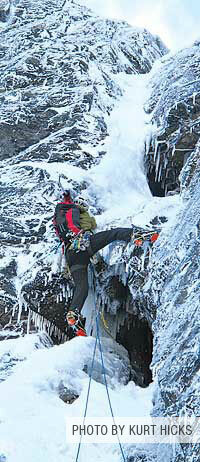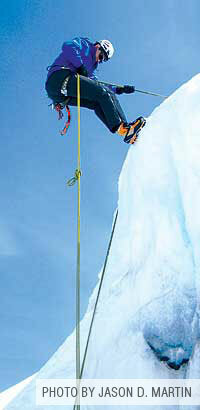Nothing like the experience of ice climbing By Jason D. Martin Photos by Kurt Hicks and Jason D. Martin  Swing. Thunk. Swing. Thunk.
My ice axe bit deeply into the vertical blue ice. Swing. Thunk. The pick of my second ice tool hit home, sinking deeply into the frozen wall. I worked my feet up the ice, kicking the sharp front-points of my crampons in until they found purchase. And then I stood still and took in my surroundings. The sky was that perfect crisp blue that only seems to exist on clear days in a Washington winter. Jagged mountains encrusted in snow stood out on the horizon. Skiers slid by on a cat track hundreds of feet below. It was a perfect day to be ice climbing on Mt. Baker Ski Area’s Pan Dome Falls. There is nothing like the experience of ice climbing. There are no other sports out there where you lash razor sharp spikes to your feet and carry two tools that look more like something William Wallace in “Braveheart” might carry than a modern mountain climber. There are no other sports where you bash a vertical ice wall into submission, while working your way incrementally up it. And there are certainly no other sports out there where you do all that while exposed to both freezing weather and extreme heights. No, there is definitely nothing like ice climbing. And that’s why it’s cool.  Modern ice climbing was born out of the need for climbers to get up progressively steeper mountain routes. In the beginning, climbers wore crampons, metal spikes affixed to their boots, with 10 vertical spikes and carried long wooden mountaineering axes. The 10-point crampons allowed the mountaineer to move freely up semi-steep icy terrain, while the long mountain axe allowed them to keep their balance and cut steps in the snow. Early mountaineers employed a special crampon position, dubbed the French Technique, to move up steep slopes. In this technique, the climber rotated his foot outward, paralleling the slope with his boot or even pointing his toes downhill in order to force all 10 of his crampon points to bite. Security came from getting all 10 points into the ice, which meant that as the terrain became serious, the climber literally had to walk uphill backward in order to be safe. Modern ice climbing was born out of the need for climbers to get up progressively steeper mountain routes. In the beginning, climbers wore crampons, metal spikes affixed to their boots, with 10 vertical spikes and carried long wooden mountaineering axes. The 10-point crampons allowed the mountaineer to move freely up semi-steep icy terrain, while the long mountain axe allowed them to keep their balance and cut steps in the snow. Early mountaineers employed a special crampon position, dubbed the French Technique, to move up steep slopes. In this technique, the climber rotated his foot outward, paralleling the slope with his boot or even pointing his toes downhill in order to force all 10 of his crampon points to bite. Security came from getting all 10 points into the ice, which meant that as the terrain became serious, the climber literally had to walk uphill backward in order to be safe.
Clearly, this method had its limits. In 1932, the European climber Laurent Grivel made a major modification to the historic crampon. He added two sharp horizontal spikes to the front, thus introducing front-points, a major revolution that allowed climbers to ascend significantly steeper terrain by kicking their toes in and standing up on them. Seven years later Otto Trott, a German immigrant, introduced these new 12-point crampons to the Pacific Northwest. The use of front-points in the Cascades led to a number of steep first ascents throughout the range, including new lines on Mt. Shuksan and Mt. Baker. In 1966, Yvon Chouinard began experimenting with new shorter ice axes with upswept reverse-curve picks. With new modified ice tools in hand, he started an ice climbing revolution. Chouinard refined old techniques and developed new ones. He taught classes and inspired young climbers, including Dunham Gooding, an aspiring mountain guide who would go on to found the American Alpine Institute in Bellingham.  Today, Chouinard is best known for his company, Patagonia. But his innovations in ice climbing equipment and techniques, combined with the innovations made in the 1930s lead to a change in perception. Anybody could climb steep or vertical ice. All they needed were the right tools. Today, Chouinard is best known for his company, Patagonia. But his innovations in ice climbing equipment and techniques, combined with the innovations made in the 1930s lead to a change in perception. Anybody could climb steep or vertical ice. All they needed were the right tools.
In Washington state, we have three types of ice climbing. The first is steep spring and summer alpine ice routes. These are often made up of a combination of frozen snow, exposed glacier and water ice. The second are winter alpine ice routes on steep mountain faces. Commonly, these snow and ice lines form from the winter’s normal freeze thaw cycles. And the third are what most people think of when they think of ice climbing: waterfall ice routes, or frozen waterfalls. “But … but, there is no ice climbing in Washington!” For years this was the automatic response given when northwest climbers were asked about potential ice routes in the Cascades or in the Washington desert. For many it was probably easier to deny the existence of climbable ice than to commit to the often grueling approaches through deep snow and avalanche terrain required to reach a winter ice route. Many thought that a trip up to Canada, where the waterfall ice is less fickle and the approaches are more manageable, might be a better option than hunting the elusive beast that is Washington ice. And for many, maybe it was. A little over a decade ago, Alex Krawarik and I set out to write a guidebook on ice climbing in Washington. Our efforts led to a number of incredible ice climbing adventures throughout the state and eventually to the publication of our book, “Washington Ice: A Climbing Guide” (Mountaineers Books). After the book was published in 2003, climbers all over the state began to look at our warm maritime mountains in a different light. They made their way up new ice routes both in the Cascades and in the cold desert east of the mountains. The book was the impetus for a renaissance of ice climbing and new route development throughout the state. But even after the book came out, there were still doubters out there. They claimed that nothing in the book ever “came in.” That’s climber-speak for when a waterfall freezes to a point where it’s in condition for climbing. These individuals claimed that while some of the routes freeze occasionally, Washington still wasn’t really an ice climber-friendly state. In some regards these doubters were right. Washington is a warm state and many of the waterfall routes with easy roadside access don’t come in every year. Some are so fickle that they only come in once every decade or so. Warm temperatures through the winter often result in waterfall ice climbs that require a lot more finesse and expertise than similar climbs in Canada. Climbers must choose their pick placements more carefully here, as the ice is variable and soft. This makes it difficult for novice climbers to learn the craft without a professional instructor. With a little effort, it is always possible to find ice. Roadside ice is less reliable and often less stable, but occasionally it comes in ‘fat’ providing a solid winter of good climbing. When the temperatures are warm and the roadside ice is poor, mountain ice often goes through a freeze-thaw cycle, which creates excellent alpine ice conditions. Ice climbing is not a sport for the meek, but it is also not exclusive. If you think you can handle the cold, the heights and the physical endurance required to climb a route, then you’re halfway there. The next step is to head to the mountains, strap on some crampons and start swinging your tools! GETTING STARTED. Ice climbing can be a dangerous sport. Unlike rock, ice is not static. It is a constantly changing medium. Ice on every waterfall climb falls down at some point throughout the season and alpine ice climbs constantly shed large chunks of ice. Aspiring ice climbers should seek professional instruction. The American Alpine Institute (AAI, alpineinstitute.com) offers private waterfall ice climbing lessons and guided ascents throughout the winter in the Cascades, in California’s Eastern Sierra and in Ouray, Colorado. AAI provides alpine ice climbing courses throughout the spring and summer on Mt. Baker and throughout the Cascades. EQUIPMENT. If you’re already a rock climber or a mountaineer, then you probably have a lot of the basics. Ice climbers will need harnesses, dynamic climbing ropes, carabiners, slings and belay devices. If you’re new to all types of climbing and you elect to take a class, most of this will be provided to you. If you’re a skier or a mountaineer, then you probably have the requisite clothing. If not, you’ll need multiple warm base and intermediate layers, shell clothing and a warm down jacket. The down jacket is often referred to as a belay jacket because while you’ll get warm climbing, you’ll spend a lot of time standing still belaying a climber in the winter shade. ICE TOOLS. There are many styles and brands. Some tools are designed for alpine ice, whereas others are designed for waterfall ice, and yet others are designed for mixed rock and ice climbing. A single tool can cost anywhere from $120 to $300. Before investing, take a class where people have lots of different tools available. Play with them all and see which one(s) you like the best. BOOTS. Mountaineering boots with a full-shank will suffice for beginner climbers. CRAMPONS. Beginner climbers will want a good all-around steel crampon that can be used for general mountaineering as well as ice climbing. All-around crampons have horizontal front-points, which tend to work better on alpine ice climbs where sometimes you’re on ice and sometimes you’re on snow. Advanced waterfall ice climbers may choose vertical front-points because they are more aggressive on steep climbs. Mixed climbers might prefer mono-points. These crampons have a single point, which can be used for difficult rock climbing moves. Most crampons run from $100 to $200. HELMET. Ice climbing without a helmet is suicide. Ice chunks constantly shed from both waterfall and alpine ice climbs. A standard rock-climbing helmet is acceptable. These range from $50 to $100. ICE SCREW. These are specialized anchors that can be screwed into the ice in order to provide intermediate protection or an anchor. Beginners generally don’t need these, but intermediates and advanced level climbers will need a number of these. Ice screws cost $40 to $70. X Jason D. Martin is an AMGA Certified Rock Guide and the Operations Director at the American Alpine Institute. In addition to working as a mountain guide, Martin is a freelance writer and co-authored “Washington Ice: A Climbing Guide.” 
| WI 1 – | Low-angle ice that does not require an ice tool. | | WI 2 – | Easy ice climbing up to 60 degrees that may be climbed with one ice tool. | | WI 3 – | 60 to 70 degrees two-tool ice climbing with good rests. | | WI 4 – | Near vertical steps up to 30 feet of sustained climbing, strenuous moves required to place intermediate protection. | | WI 5 – | Near vertical or vertical steps up to 60 feet of sustained climbing, strenuous moves required to place intermediate protection, few good rests. | | WI 6 – | Vertical climbing with no rests for the entire pitch (60 to 200 feet), requires a high level of technique and excellent fitness. |
|